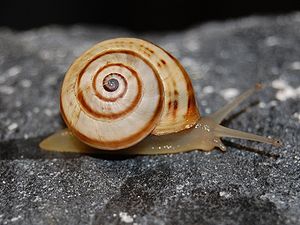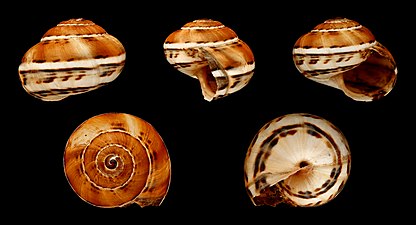Mediterranean sand snail
| Mediterranean sand snail | ||||||||||||
|---|---|---|---|---|---|---|---|---|---|---|---|---|

Mediterranean sand snail ( Theba pisana ) |
||||||||||||
| Systematics | ||||||||||||
|
||||||||||||
| Scientific name | ||||||||||||
| Theba pisana | ||||||||||||
| ( OV Müller , 1774) |
The Mediterranean sand snail ( Theba pisana ), also known as the Mediterranean sand snail or dune snail , belongs to the family of snail snails (Helicidae), which belongs to the order of pulmonate snails (Pulmonata). The species is very drought-resistant and tends to be abundant.
features
The shell of the Mediterranean sand snail is flat, conical, spherical in its overall habit, with broadly arched coils and flat seams in the adult stage. Juvenile animals, on the other hand, are still clearly keeled, the keel only disappears with the last contact. When fully grown, the case measures 9 to 12 mm in height and 12 to 25 mm in width. 5.5 to 6 whorls are formed which increase relatively uniformly. The mouth opening is elliptical, the edge of the mouth is relatively sharp and only slightly bent on the inside of the spindle. Inside it is provided with a reddish or whitish lip. The navel is relatively narrow and z. T. covered by the hem of the mouth. The almost smooth surface only has very fine spiral stripes that intersect with the also very fine growth stripes. The basic color is very variable and ranges from whitish to yellowish, reddish to brownish. Very variable dark spiral bands are often formed, but they can also be completely absent. The bands are often interrupted, jagged or split, the spaces between them are colored orange-red. The soft body of the animal is light brown to light yellow.
Occurrence and way of life
The species mostly prefers dry locations near the coast, especially near dunes and relatively sparse vegetation. In dry weather, the animals often sit in large numbers on plant stems where they are exposed to direct sunlight. The mouth is then closed with a chalky skin. In the Mediterranean area they take a summer dormancy. In the northern part of the distribution area, however, there is a hibernation.

The distribution area is Mediterranean to Atlantic. The species occurs in the entire Mediterranean area along the coasts, but also along the Atlantic coast to Belgium, the Netherlands, southern England and Ireland as well as on the mid-Atlantic islands. It is rarely found further inland. The only occurrence in Germany is on Heligoland, where it was introduced. In the meantime it has also been abducted to Australia, South Africa, Argentina and North America (Oregon). It does not tolerate lower freezing temperatures.
Reproduction
Sexual maturity is reached in many areas in the first year, the animals can reproduce at half the (adult) housing size. They are hermaphrodites that fertilize each other. Self-fertilization does not occur. About five clutches are produced per year, which are laid in the northern range in summer and autumn. In the drier Mediterranean regions, however, the eggs are laid later with the onset of autumn rains in autumn and winter. A single clutch contains an average of over 70 eggs that are buried in the ground. A total of up to 340 eggs are laid each year. The animals live in the coolest and warmest extremes of the range up to two years old. In other regions with moderate warmth and sufficient humidity, the animals do not hibernate and only rest briefly in summer. They are therefore only one year old.
Harmful effect
The Mediterranean sand snail is considered a pest in citrus plantations in Israel.
Systematics
The species was first scientifically described in 1774 by Otto Friedrich Müller as Helix pisana . Due to the great variability in coloration, the species was described under a number of other names. The Fauna Europaea has twelve synonyms . Helix pisana is the type species of the genus Theba Risso, 1826.
supporting documents
literature
- Klaus Bogon: Land snails biology, ecology, biotope protection. Natur Verlag, Augsburg 1990, ISBN 3-89440-002-1 , 404 pp.
- Rosina Fechter, Gerhard Falkner: Mollusks. (= Steinbach's natural guide. Volume 10), Mosaik-Verlag, Munich 1990, ISBN 3-570-03414-3 , 287 pp.
- Michael P. Kerney, Robert AD Cameron, Jürgen H. Jungbluth: The land snails of Northern and Central Europe. Paul Parey, Hamburg / Berlin 1983, ISBN 3-490-17918-8 , 384 pp.
Individual evidence
- ^ A b Robert H. Cowie: The life-cycle and productivity of the land snail Theba pisana (Mollusca: Helicidae). In: Journal of Animal Ecology. Volume 53, No. 1, Oxford 1984, ISSN 0021-8790 , pp. 311-325, JSTOR 4359 .
- ^ Vollrath Wiese: The land snails of Germany. Quelle & Meyer, Wiebelsheim 2014, ISBN 978-3-494-01551-4 , p. 306.
- ↑ Carolin Däumer, Carola Greve, Rainer Hutterer , Bernhard Misof, Martin Haase: Phylogeography of an invasive land snail: natural range expansion versus anthropogenic dispersal in Theba pisana pisana. In: Biological Invasions. Volume 14, No. 8, 2012, pp. 1665-1682, doi : 10.1007 / s10530-012-0179-z .
- ^ Giulia Forni, Cesare Francesco Sacchi: Ecologia di un ivasore. L'Elicide mediterraneo Thebo pisana a Port Elizabeth (Sudafrica): aspetti minimalistici. In: Studi Trentini di Scienze Naturali Acta Biologica. Volume 78, No. 2, Trient 2002, pp. 29-36.
- ↑ Alejandra Rumi, Julieta Sánchez, Noelia S. Ferrando: Theba pisana (Müller, 1774) (Gastropoda, Helicidae) and other alien land molluscs species in Argentina. In: Biological Invasions. Volume 12, No. 9, 2010, pp. 2985-2990, doi : 10.1007 / s10530-010-9715-x .
- ↑ Pest Risk Assessment for the State of Oregon ( Memento of the original from June 16, 2010 in the Internet Archive ) Info: The archive link was inserted automatically and has not yet been checked. Please check the original and archive link according to the instructions and then remove this notice. (PDF; 963 kB).
- ^ Dora Godan: Molluscs Their Significance for Science, Medicine, Commerce and Culture. Parey Buchverlag, Berlin 1999, ISBN 3-8263-3228-8 , 203 pp.
- ↑ Otto Friedrich Müller: Vermivm terrestrium et fluviatilium, seu animalium infusoriorum, helminthicorum, et testaceorum, non marinorum, succincta historia. Volume alterum. pp. I-XXVI [= 1-36], 1-214, [1-10]. Heineck & Faber, Havniae & Lipsiae, 1774 Online at www.biodiversitylibrary.org (p. 60).
- ↑ Fauna Europaea














